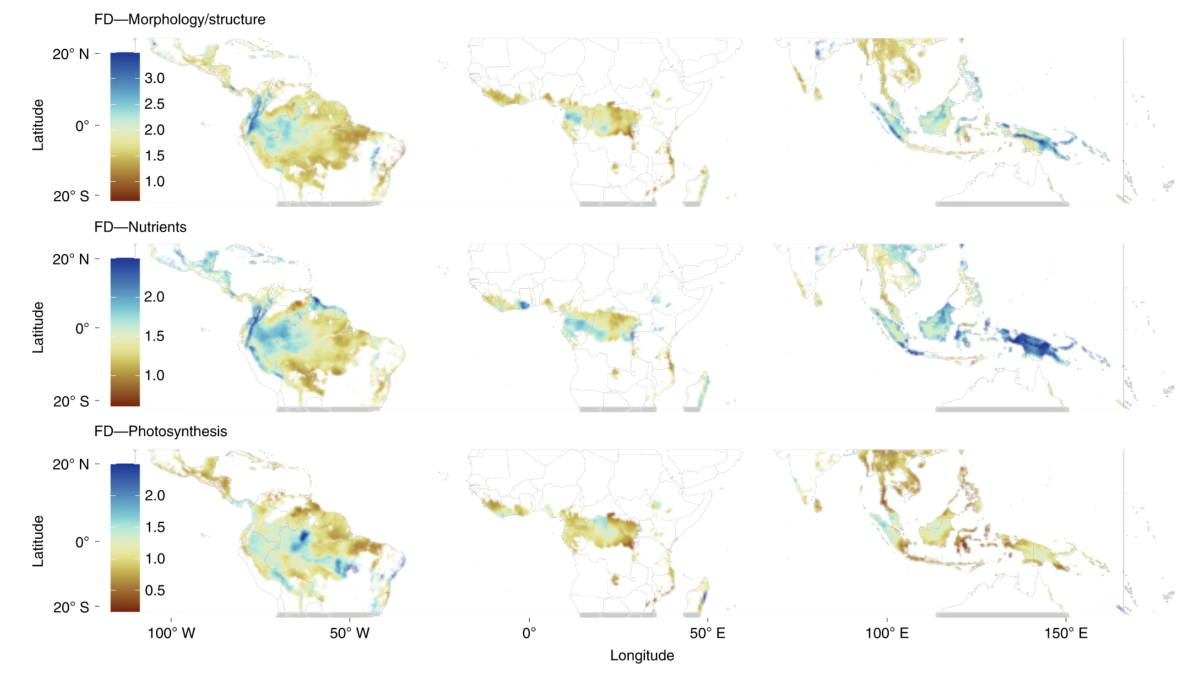ASU scientists study the response of tropical forests to climate change

Global predictions of functional diversity across tropical and subtropical, dry and moist broadleaf forests. Reprinted from “Functional susceptibility of tropical forests to climate change,” by J. A.Gutiérrez, 2022, Nature Ecology and Evolution.
Beneath green canopies of towering trees, vivid colors flash by on outstretched wings, while underfoot, a small green tree frog leaps onto a large leaf. In the distance, a chimpanzee reaches for a fruit hanging above his head. This is a tropical forest, rich with life and teeming with biodiversity.
While covering only about 6% of the Earth’s surface, tropical forests support more than 80% of the world’s documented species. And these ecosystems are one of the oldest on the planet. Yet human development and a changing climate threaten the forests’ ability to function properly.
To protect and restore tropical rainforests, Arizona State University researchers joined a study led by Oxford University to uncover critical information about the forests and their ability to respond to the impacts of climate change.
The study looked at functional diversity, or the range of functional traits that an ecosystem needs to operate. In the study, published May 16 in Nature Ecology and Evolution, the team of researchers mapped out the functional diversity of forests. The findings demonstrate that drier forests are less functionally diverse, meaning that they may be less resilient in the face of increasing droughts.
“For thousands of trees distributed all across the tropics, we collected information of certain characteristics that allow them to respond to changes in the environment, such as increasing droughts, which we call ‘functional traits,'” said Jesús Aguirre-Gutiérrez, lead author of the study and senior researcher with the Environmental Change Institute at the University of Oxford. “Using this information, we built models to understand if and how the diversity of functional traits increases the resilience of forests to climate change.”
Spanning 74 sites and four continents, the team used local climate data for the past 50 years combined with data on 16 different plant traits sampled from 2,461 individual trees. This combination of data allowed the team to gain a big picture view of the forest changes, specifically how the forests’ responses to climate change differ based on the dryness of the ecosystem. Overall, drier tropical forests are less functionally diverse and more functionally redundant — many species perform the same roles.
“This research informs conservation efforts by identifying regions more susceptible to climate change, allowing managers and policymakers to take more targeted and educated action,” said Greg Asner, co-author of the study and director of the Center for Global Discovery and Conservation Science. “We must discover where and how to invest for long term ecosystem resilience.”
More Environment and sustainability

Mapping the way to harvesting water from air
Earth’s atmosphere contains about 13 trillion tons of water.That’s a lot of water to draw upon to help people who are contending…

ASU researchers test environmental risks of tire emissions on Arizona highways
The Greater Phoenix area’s roadway grid system is the envy of urban planners everywhere, and the Arizona…

A 6-month road repair that only takes 10 days, at a fraction of the cost? It's reality, thanks to ASU concrete research
While Arizona’s infrastructure may be younger than its East Coast counterparts, the effects of aging in a desert climate have…

